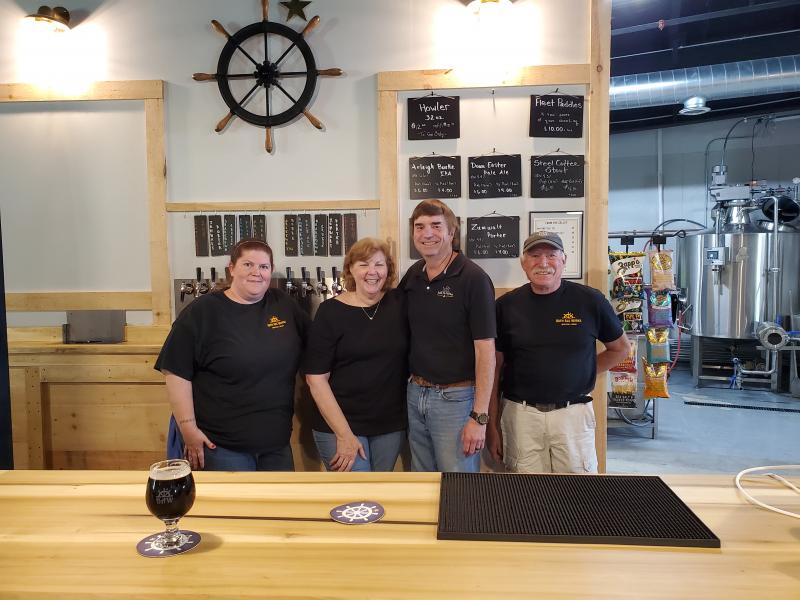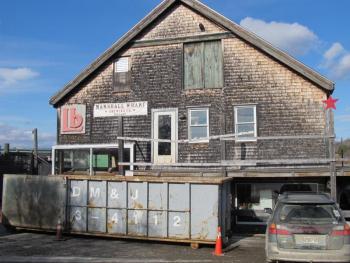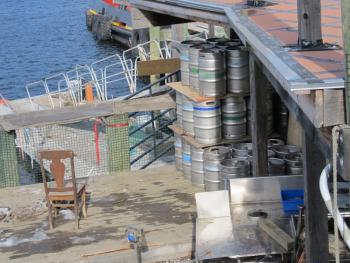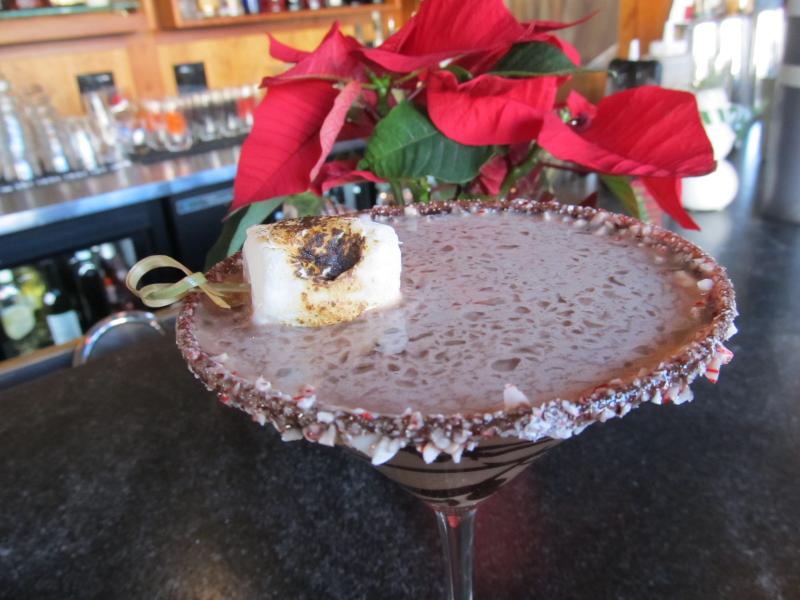...which is actually in Wiscasset, not Bath Note: this story originally appeared on Penobscot Bay Pilot. WISCASSET—Ironically, Wiscasset’s first brewery is named after the nearby town 10 minutes away, but there’s a story for that. On Route 1, opposite from the Shaw’s Supermarket, Bath Ale Works, co-owned by Pepper and Jean Powers opened its brewery and taproom Memorial Day Weekend. Powers, who arguably has one of the coolest brewer’s names ever, said, “We had the idea to open up in Bath several years ago, but we never found the right building at the right time, and then when we did, we waited two years to move into a building that ultimately never got built.” Powers, who has home-brewed since 1993, decided to set his sights on the property at 681 Bath Road, a division of the adjacent Family Dollar Store. “The Midcoast has a rich, maritime heritage with shipbuilding, not just with Bath Iron Works, and we wanted the brewery name to reflect that kind of Midcoast nautical feel,” he said. The vacant building was a challenge to transform. When other tasting rooms were shut down due to the social-distancing and capacity mandates last year, Powers and his crew used the time to build out the entire brewery, including a cold storage room, a lab, and a serving cooler. “For everyone else, it was a hard time, but for us, the timing was a blessing in disguise,” he said. The spacious taproom doesn’t have the deliberately industrial feel as many Portland breweries do, but it feels like there’s a lot of room to spread out. It offers numerous multiple sitting areas for parties of two and four, a game shelf, and a central bar. It is kid- and dog-friendly and patrons are welcome to bring in their own food. On weekends, the confidently-named food truck “Shut Up and Eat It” is parked in the lot, serving homemade chili corn dogs, wings, pizza, and other pub-style food. “Sometimes I have to explain to customers what the food truck name means— that I’m not yelling at them,” joked taproom manager Tanya Gamache. The taproom also offers “Galley Boxes,” which are mini Ploughman’s lunches with cheese, meat, bread, pickles and roasted nuts. Powers, who favors traditional English and Continental styles, brews two days a week. Currently, the Down Easter Pale Ale, their flagship beer is a lightly-hopped, well-balanced brew and the Shakedown Cruise Ale (which is 8.1% ABV but you’d never know it given its light, floral taste). But his Steel Cutter Stout, named after common work activity at Bath Iron Works, is worth exploring. Even beer lovers who tend to gravitate to the lagers and lighter beers will appreciate this clean, tasty black ale. One sip and a cascade of flavors hit the palate finishing with a“nicely roasted barley bite.” This summer, Bath Ale Works, is building out its courtyard behind the taproom, set in a heavily wooded and secluded area, where patrons can enjoy a brew with family or friends and play cornhole. They’re hosting their first cornhole tournament coming up Friday, June 18. More info can be found at the Bath Ale Works website and Facebook page. Kay Stephens can be reached at [email protected]
0 Comments
Note: my story originally appeared on www.penbaypilot.com
Ten months ago, Maine’s brewing industry came to a screeching halt the day after one of the biggest beer-drinking days of the year, St. Patrick’s Day, when the novel coronavirus pandemic prompted Governor Janet Mills to issue an Executive Order on March 18, 2020 to close all bars and restaurants for a period of 14 days. Back then, for many at the beginning of this unknown pandemic, the assumption was that breweries, bars, and tasting rooms would eventually re-open and it would be business as usual. But, on March 31, when Mills issued the Stay Healthy at Home directive that required Mainers to stay at home at all times unless venturing out for necessary purposes, the brewing industry—like so many other industries in Maine, saw the writing on the wall. Since the spring, breweries with restaurant service fared a little better. They were able to re-open for indoor service, while breweries with take-out options and outdoor seating were able to capture some of the lost revenue during the summer, but as of November 1, with COVID-19 cases on the rise in Maine, Mills issued a mandate to postpone the opening of indoor seating at bars and tasting rooms. Lowered excise tax law boosts cost savings for breweries, beer lovers The industry got a shot in the arm with a new law announced in late December that permanently lowers excise tax for brewers, according to the office of U.S. Senator Susan Collins, who, along with Senator Angus King, and a bipartisan group of 55 colleagues, championed for the law in order to help breweries —and their brewing supply chains—stay open. Given that Maine has the highest excise tax for beer in New England at $.35/gallon, this came as welcome relief to brewers already cash-strapped from the pandemic. Maine leads the nation when it comes to the recent rapid growth of its beer industry. In 2018, the industry added $2 billion to to Maine economy, according to a study jointly issued by the Beer Institute and National Beer Wholesalers Association. That year, Maine’s beer industry added 15,531 jobs, paying a total $595,273 in wages. – Economic Impact of the Beer Industry “In Maine, we have one of the highest state excise tax rates, almost triple some of the New England states,” said Sean Sullivan, executive director the Maine Brewers Guild. “Add that to the production challenge of switching to predominantly canned beer, as well as shortages of aluminum cans, these were additional trends hurting the industry.” In 2017, the American craft beverage industry got a break when a temporary federal law lowered the excise tax of $7 per barrel to $3.50 per barrel, which was set to expire on December 30, 2020. “The risk was that as of January 1, that federal excise tax rate was going to go back up to $7 a barrel,” said Sullivan. “More than 25 breweries opened during the last three years that had never paid that amount per barrel, and hadn’t factored that into their costs. Picture yourself as a brewer, heading into a winter where you didn’t have a good economic summer, and then all of a sudden your taxes go up twice the amount you’re used to paying on each barrel.” “Maine’s beer industry has been on a growth trajectory for years,” said Sullivan. “Maine brewers produced about 365,000 barrels of beer in 2019, which equates to about $1.25 million in revenue. So, to break it down, as of the beginning of 2021, either $1.25 million was going to remain in Maine for breweries to re-invest in their business, or else it was going to go to the federal government in the form of excise tax, if tax rates were raised back to $7 per barrel.” Maine brewers come together as one brand to collaborate on brew recipe Liberator Brewing Co. is brewing the Collaboration Beer 2020 and owner Rich Ruggerio said, “It should be available on tap near the end of January.” Another spot of good news for an industry known for its tight and collaborative communities in all of Maine’s eight regions was the decision to create a Collaboration Beer 2020. Thirty-nine breweries all over the state, including Liberator Brewing Co., in Rockland, and Waterman’s Beach Brewing, in South Thomaston, received the same donated hops, malts, and grains and one recipe to work off. The result of that effort turned into 39 brews, all under one label, each a slightly different flavor based on how they used their own yeast, base malts, and brewing techniques. Proceeds from the beer have not generated some much-needed profit for the industry, but have also gone back as donations to bolster the Maine Brewers’ Guild. “I’ve tried so many versions of this beer,” said Sullivan. “It’s remarkable how different they taste. I think this Collab Beer is a beautiful example of what makes our industry so special. Amidst the commonality of brewing beer, even often the same style, there is infinite diversity. Wherever you are in Maine, look for this label and check the back for which brewery brewed the beer. ” For a list of breweries that participated visit Brewbound.com Note: my story originally appeared on www.penbaypilot.com
APPLETON—Maine Cater, a recruitment company dedicated to serving New England’s food and beverage industry, has come up with an idea to provide local “restaurateurs, employers, job seekers, and FOH/BOH” with an economic lifeline during a pandemic that shows no signs of stopping. Husband-and-wife team, Daryle and Orianna Degen launched Maine Cater in Camden in 2017 as a way to supply temporary employees to restaurants suffering from immediate gaps in employment. “We’ve both worked in the hospitality industry all of our lives, said Degen. “I used to be a relief chef in England and Scotland helping short-staffed restaurants for years, but when I moved to Maine, I realized there wasn’t any service that could quickly plug in a chef or a server or a bartender into an existing restaurant if the restaurant was short-staffed. Given Orianna’s background in FOH (front of house) management and mine in BOH (back of house) management, we decided to start our own company.” Since the COVID-19 virus hit, the couple left their Camden location and now operates remotely out of their Appleton home. In addition to providing the public a job board for the restaurant industry in all of new England akin to Craiglist or Indeed.com, the couple recently announced a community service arm to their job board. Whereas before, employers looking to post on Maine Cater’s Job Board could do so for free. But now, adjusting their model, it requires a $25 fee— the majority of which goes back into a fund to assist workers and restaurants. “Employers are already paying $25 to some of the larger corporations such as Craigslist in order to post jobs, so why not support a local company?” said Daryle Degen. “And in return, we invest the funds they paid and put it back into the industry to help other businesses and restaurant workers.” As PenBay Pilot reported two months after the COVID-19 virus shut down indoor dining for the majority of Maine’s restaurants and bars in a story, “Open? Close? Adapt to permanent Takeout?” the restaurant industry was left flapping in the wind. The Paycheck Protection Program was not a huge success and came with too many strings attached to be workable for many businesses. A dire prediction from restaurateur John Stowe, owner and chef of Rockland’s Rustica, interviewed for that article is now coming true. “...The reality is the pivotal moment won’t take place this summer; it’ll be after the winter, where you’ll see more restaurant closures,” said Stowe. “So, if locals love their favorite restaurants, the best thing they can do is continue to go there, get gift certificates and continue to support them past the summer.” “To put it in a harsh reality, the restaurant industry is in a pretty bleak state,” said Degen. “Without any help from the federal government, I don’t foresee many places surviving, especially with all of the state restrictions on top of that. It’s making it impossible for restaurateurs to survive the pandemic as we enter the ‘Dead Season’ in January. That’s typically where restaurants rely on the income they made in the summer and many of them didn’t have that safety net this year.” When a restaurant’s margins are razor-thin, it trickles down to the employees. “A lot of servers have also left the industry, where they were just not making enough,” said Degen. “It’s an industry not known for being able to offer the best wages and benefits.” It’s more than that: it’s a Perfect Storm of economic disparity. Seventy percent of restaurant servers are female and yet, women have been disproportionally hit the hardest with the pandemic, particularly those with small children and who live in districts where schools are doing remote learning. Giving Back Through A Worker Fund and a Restaurant Fund Maine Cater spells out clearly in a blog post titled Community Service what they intend to do with the employer job listing fee. “The $5 from the $25 will go towards credit card processing fees and job board software upkeep, and the remaining $20 will go into the chosen fund account,” states the blog. To kick-start the fund accounts, Maine Cater will put $500.00 of its own money into each fund. They will keep track of which employers in New England states and regions are posting the jobs. So, if a Midcoast restaurateur pays the $25 fee, the $20 will go into a fund for Midcoast servers and restaurants. “For the Worker Fund, we will be offering several types of assistance,” said Degen. “One is a disaster relief assistance, where if a worker is struggling to pay his or her rent, or is facing eviction, we will be building up that fund in order to give back to that individual. The other way we’ll distribute funds is to issue gift certificates to workers so they can dine out or buy take out and feed their families. We can also use those funds to drop a large tip to a particular restaurant, whether it’s one or two thousand dollars, which the workers can split. There are a number of ways we can give back to them, directly.” The Restaurant Fund focuses on the economic health of local restaurants. Maine Cater will supply restaurants with gift cards to their own restaurant that either Maine Cater gives away to the public or the restaurateur hands out to guests. The funds can also be pooled to give away to hotels with attached restaurants for a “Weekend Getaway’ package. “We can buy gift cards to multiple restaurants so that restaurants paying into the job post funds end up helping one another stay afloat,” said Degen. “It creates an ecosystem of restaurants supporting other restaurants.” The other benefit to restaurants when customers use a gift card, say $50, is that the customers often spend well above the gift amount, increasing the ticket average for the restaurant. A General Fund is also being built with the purchase of a resume package and job listings ($290) to directly benefit food banks, rent or disaster relief assistance for industry workers, and larger prize giveaways like weekend getaway packages, etc. Currently, this system is not open to receiving general donations from the public; it’s all through the economic investment of restaurateurs. Maine Cater aims to launch this new program in mid-December. To follow their updates visit: https://www.mainecater.com Former employee of Marshall Wharf Brewing Co. and wife bring Belfast business back to life2/18/2020 BELFAST—The sound of construction can be heard in and around the two buildings that comprise Marshall Wharf Brewing and Three Tides these days.
It’s business as usual for builder Daniel Waldron, co-owner of Whitecap Builders; but he isn’t just working on the buildings. He and his wife, Kathleen Dunckel, recently purchased the brewery building and property prior to a public auction on January 29. They also purchased the brewery business and Three Tides business. As a former employee of Three Tides and Marshall Wharf Brewing, Waldron couldn’t get the brewery off his mind. It had abruptly closed in April 2019 after floods over the previous winter had caused severe damage, according to an article in the Bangor Daily News. “I started seriously considering buying it last June,” said Waldron. As it got closer and closer to the auction, we kept thinking, ‘how can we make this happen?’” As a builder, Waldron eyed the buildings with a certain perspective that comes with the territory. “I fell in love with that brewery building when I was working here,” he said. “It was an old grainery and has been standing here on the Belfast waterfront since the late 1800s and the upper levels of the building have never been touched.” Rising tides, storm surge and climate change made the brewery extremely vulnerable to flooding, a calamity which destroyed a substantial amount of the hard work done by original owners David and Sarah Carlson. According to BDN, a one-two punch in the winter and spring of 2019 in the form of floods wiped out their stainless steel tanks that contained finished beer and then took out more smaller tanks two months later. To be viable as a brewery in the long run, Waldron said the entire building needs to be jacked up approximately eight feet from the current first floor elevation. “It’s been there so long it’s sinking,” he said. “Currently, the first floor of the building is 38 inches below the sea wall. We just need to get it jacked up on piers, out of the ocean’s way.” “We do this every day,” he said, of the construction. “For me, the immediate challenge is getting the brewery and restaurant back up and running again.” Waldron, who has been in the restaurant business 20 years as a supplement to his construction work, served as a Three Tides bartender. Dunckel is a professor at Unity College. With three children, the couple is spending every available moment to bring back the beloved brewery and bar to the way people remember it. At the time of this interview the couple had a verbal agreement to lease the Three Tides property from the current owner with intent to purchase it in the future. “The feedback we’ve heard has been so positive and a lot of what we’re hearing is: ‘We miss Three Tides and Marshall Wharf Brewing. We want our place back.’ And we want to give it back to them.”—Kathleen Dunckel As for Three Tides, Waldron doesn’t need to do anything drastic. “The kitchen needs some new equipment a potential expansion, but we’re planning on leaving it mostly the way it was,” he said. The couple said they are working toward a spring re-opening while they work on planning, engineering and a slew of city, state and federal permitting applications for the major rehabilitation of the brewery building. “We’ve got protections in place for flooding right now,” he said. “We’ll operate out of both spaces, until all the permits are in place and then the brewery will need to shut down again and brew offsite, so we can jack the building up.” The Belfast community has expressed an outpouring of excitement toward the re-opening. “David and Sarah were super supportive and the community has been off the hook since we posted the plans on Facebook,” said Waldron. “Other restaurants and brewers, such as Danny McGovern, have also reached out and given us their support.” Jared Mahrunic, MW’s head brewer, is returning to restart the brewery. One of the biggest questions the couple is getting is: “Will the same beers come back?” The answer is yes. “Everything will still be branded Marshall Wharf and all of the beers that people love will be coming back,” said Waldron. “We’re honing in on what Marshall Wharf already does well.” He said: “We’re not quite sure what capacity we’ll offer food yet It’ll be light fare, tapas to start.” As for entertainment, Marshall Wharf Brewing has always served as an anchor for the major Belfast music festivals and harbor parties. “I think that’s definitely on the horizon,” said Dunckel. “We’ve already been contacted by bands and my take on that is that it’ll be a soft, subtle start as we get going,” said Waldron. “But the music side has always been a big thing for us. If we revive anything for now, it’ll probably be the Marshall Wharf beer and mussel festival in October, depending on how much beer we have available then.” Basically, Belfast is getting the same brewery they’ve always loved back. “Coming here after work in July or August and grabbing a pint and seeing the people you work with, people in your community and tourists hanging out, enjoying the sun down in the Three Tides beer garden on the harbor — this place has always felt like an old English pub,” said Waldron. “That’s how it’s going to be again.” Kay Stephens can be reached at [email protected] Unlike some of the U.S. National Toboggan Championships teams who’ve sported elaborate and over-the-top costumes in the past 29 years, the founding members of Big Kahoonas— Bruce Richards, Chris Lepow and Edwin Greenrose, along with original member Bill Patten, didn’t worry too much about style. The uniform has always been a dark green embroidered sweatshirt with a fleece hat or ball cap. That’s it, Bub.
Most of the Kahoonas’ energy goes into the making of the toboggan, along with their myriad strategies to win as many of the races as they can. But, if you want to know where the real secret sauce comes from — behold The Stupid Stick. Shamans may need ayahuasca in order to conjure the divine—all the Big Kahoonas need is a wooden toboggan runner and eight plastic shot glasses of Dr. McGillicuddy, a flavored spirit that doubles as Prestone De-Icer window washer fluid. On the count of three, The Stupid Stick is tipped back and everyone takes a community shot of the Doctor. Since they first started competing in 1994, when they were all about 24 or 25 years old, the Big Kahoonas have always raced in multiple heats of two-, three-, and four-person teams. As the years have gone by, the fourth member of the team usually revolves out. With the addition of Greg Sheldon this year, the Fabulous Four are ready to tackle the chute again. Asked what keeps the momentum up to keep the team together for the 30th year, and Richards will tell you it comes right down to good old-fashioned competition—with his brother, Sean. “My brother’s team is the Throbbin Boggins and they started a year before we did,” said Richards. “They are our biggest competitor and our partners in crime, as well. So, we can’t stop.” The team met at Greenrose’s shop in Union last week to work on their latest iteration of a toboggan with ash slats. All told, the team has probably fashioned 10 to 15 toboggans in their racing career. “We used to build new ones every couple of years,” said Greenrose, who is a builder in his profession. Richards is an exterminator. “I just kill stuff,” he said. This year, the team went all Martha Stewart and decided to cut an ash tree down themselves to make the toboggan. They finished off the design by steam bending the runners over a circular form with a steam box. “Bruce is the one who comes up with these crazy ideas for design,” said Greenrose. “They work!” Richards shot back. “We’ve tried all kinds of stuff over the years, different waxes, different combination of the wooden slats, different hand rails,” said Greenrose. “The new ones seems to go faster. This one we’re working on eliminates the hand rails, so it might be a little more flexible. We’ll see if it helps. It’s funny I tell people how long we’ve been doing this and when it comes to building the style of toboggan, we are right back to where we first started in its design. Our same sled, our same finish, our same wax.” The team doesn’t ever do practice runs, but has faith nothing will go wrong. “We’ll probably stop half way down,” said Greenrose. Given how many combinations of teams the Big Kahoonas have, they will be stationed at The Camden Snow Bowl all weekend long, running multiple heats. The payoff for them is about community. “It’s fun to get together, it’s not like we hang out all of the time,” said Greenrose. The big white trailer in the parking lot that serves as their home base belongs to Throbbin Boggins and the two teams share it well. “We just put a Big Kahoonas sticker on the trailer to drive my brother crazy,” said Richards. It also serves as their warming shack and makeshift bar. “We make use of The Stupid Stick every 20 minutes,” said Greenrose. “People are always coming by the trailer to say hi. Our whole area is always packed. We have people you don’t see all year long until the Toboggan Races. All the teams give each other hell. It’s pretty good camaraderie.” In years past, the weather has had a major effect on the teams’ racing times. If it’s frigid cold this year, that’s fine—it’s better for racing. But if it’s snowing or if Hosmer Pond is bumpy, the team members —who always roll off the sled at the bottom to avoid scarring the wood—will probably walk away with bruises the size of hematomas. That’s OK. But if it’s raining, that’s going to be bad. Real bad. “Because, I’m the one in front and the second you hit Hosmer Pond, the sled hits a lake of ice water,” said Greenrose. “It’s like going through a frozen log flume. The water shoots right up my pant leg. And you know I’ll be sick three days later.” Featured on this year’s U.S. National Toboggan Championships official poster, the Big Kahoonas have a fan club, but they don’t let it go to their heads. “Our whole name is a play on words for you know...” Richards trails off, leaving the meaning up to interpretation, but insinuating it has something to do with the particular part of men’s anatomy that symbolizes courage. “But it’s about a bunch of guys doing stupid stuff.” For more information on the Camden Snow Bowl’s U.S. National Toboggan Championships visit Camden Snow Bowl Kay Stephens has been writing about the U.S. National Toboggan Championships since 1999. She can be reached at [email protected] The power of your local library card just got 70x more powerful.
As public libraries serve as welcoming “third” spaces in our Midcoast communities, there are so many new resources and programs offered that the public has access to. Only, so many people still don’t know about them. Not surprisingly, it was Maine’s librarians themselves who brainstormed alternative ways to give more people in the state broader access to libraries. At The Maine Library Association's Fall 2018 Conference (including the Maine InfoNet Pre-Conference) librarians in attendance “expressed a strong desire to develop initiatives that would strengthen broader library resource sharing across Maine,” according to Maine.gov’s website. That conversation developed into a pilot program called the Maine Reciprocal Borrowing Program in September 2019, which will wrap in September 2020. It's referred to as “walk-in,” borrowing card, because if you possess a local library card, you can walk into 68 libraries around the state and check out items. A van goes around weekly to the libraries and does delivery service, scanning the bar codes and bringing the inter-library loan items back to the original libraries. Many libraries have deliveries every week day; some libraries have fewer. Amy Levine, director of Rockland Public Library said, “We jumped on board as soon as we knew the state was going to do this pilot program, because it’s just such a great opportunity to extend our services. People like the flexibility and the opportunity to walk into most of the libraries in the state and check something out on the spot.” The Advantages of Having a Card For young and low-income residents In the past, if you wanted a library card, you usually got the cheapest deal in the town you lived in, often for free. But, that limited you to the offerings of that particular library. If you lived outside the town, you had to pay for a non-resident library card. The tiers have changed over the years, but today, a single non-resident membership in some Midcoast libraries is nearly $50, (due in part to how the library is funded by taxpayers). Still, with rents, food costs and utilities in Maine higher than the national average, choosing necessities over purchasing a library card tends to be the case. Now, if you are a resident of Camden, Rockport, Rockland, or Belfast, you can obtain a free card and access certain unique items and collections of other libraries that were previously off limits to non-cardholders. For college and grad students College and graduate students in Maine, now are also finding this pilot system incredibly convenient. Colby, Bates and Bowdoin are all participating as well, so Midcoast collegiates can borrow school-related materials from the colleges, and return them to their participating hometown libraries, eliminating the need for a long commute. Immediate access Adding to the power of the card is the already existing Interlibrary Loan Service (LLC), where participating libraries use a courier to deliver library books and materials from one library to another. “If someone wants a book, we can usually get it in less than a week, through the van delivery, if it’s not a really popular title, but if the person needs it right now, he or she can go to the library where it is available, walk in and check it out right on the spot,” said Levine. Not everything is allowed to be borrowed, however. “Every library has a few things off limit, and for us it’s about the devices,” said Levine. “For example, we have a telescope and musical instruments that are not available for this program.” Steve Norman, director of Belfast Free Library, said of the new pilot program, “This is another example of how libraries work together to provide better service to the public. There was a small group of libraries in southern Maine that had reciprocal borrowing agreement for a couple of years and we also used their model as our template.” “People who commute are especially pleased,” he said. “If they live in a town with a participating library, yet work in another town with a participating library, [borrowing and returning materials] works out very well for them.” Norman said almost everything that a Belfast Free Library card holder can check out works out the same for a cardholder from a participating library. “They can check out everything with the exception of special equipment and kits,” he said. For at least eight more months, Maine taxpayers and residents should put their cards to work at participating libraries and literally “check out” new resources while they still can. Participating Midcoast Libraries One card gets you access to all four Midcoast libraries. Find out what you can check out by clicking: Camden Public Library Rockport Public Library Rockland Public Library Belfast Free Library Wiscasset Public Library Boothbay Memorial Library Skidompha Public Library Kay Stephens can be reached at [email protected] Well, this is cool! The newspaper where I've been working for the past 7.5 years has archived all of its writer's stories. So, here's a handy reference. Click on the link below for all of the arts and entertainment and interesting happenings of Midcoast Maine going back to 2012.
CAMDEN—After all of the gifts are unwrapped, the leftovers are put away and the hoopla dies down, it’s time for the adult equivalent of that last little bit of chocolate or candy cane in the bottom of your stocking. It can be found in Old St. Nick, a deliciously frosty cocktail crafted at Hoxbill in Camden Harbor.
Beverage Director Marcus Carter collaborated on the invention of this drink just in time for the holidays. Upon the first swig, it’s an arctic blast of peppermint, followed by the sweet crunch of candy cane and rounded out by creamy maple. Then, take a bite of gooey toasted marshmallow—the cocktail’s garnish. It is a jolly, jolly sip—and meant to be savored, preferably by a roaring fire. This cocktail takes a bit of preparation. First the rim of a martini glass is dipped in melted chocolate. After putting a candy cane in a Ziploc bag and smashing it down to granules with a hammer, Carter then dips the rim a second time, so the glass comes away coated with chunky, swirly bits. “People are loving it,” said Carter. “It is a dessert drink, however, not typically one you’d start out with. People are coming in after they’ve had dinner at home and giving it a try. Or after a meal here, instead of dessert, this caps off the night with a sweet finish.” Watch the video to see how the cocktail is made. You’ll need:
Make the cocktail yourself this holiday week or have it made for you. Hoxbill is not open on December 25, but will be open the following day. Related: See some of our past holiday cocktails. Kay Stephens can be reached at [email protected] ROCKLAND—On Wednesday, December 18, a classroom in Rockland’s South School looked like a book sale with 4,600 children’s books filling every available table and box underneath.
The best part? Every single book was given away for free. This is the fifth year educator Jenny West got to feel like Oprah Winfrey and do the “Favorite Things” Giveaway, in which every student from South School got to pick 10 books to keep and bring home. “I started the Books in Every Nook program years ago because I’m a reading teacher here at South School and I was finding that many students didn’t have books in their homes,” she said. “So, to solve that problem, I came up with the idea of gathering new and used children’s books and then re-distributing them to students once a year.” Not many people realize how much work goes on behind the scenes to do this giveaway. West spends her time year-round collecting books and a number of volunteers help her to set it up. “I get books everywhere,” she said. “I collect a lot over the summer from library book sales. I go to yard sales. I get books from local publishers and authors who donate books every year and then I get people who donate money for me to go out buy books.” “In past years, we’d typically allow students take five books home, but we have 300 students this year, and with so many to give away, I’m allowing them to take home 10,” said West. In 20-minute increments, each grade assembled inside the classroom where West explained how to select a book and how many could be taken. The reaction from the students when they discovered they could select 10 this time, was to simultaneously throw their hands up in the air and cheer or jump excitedly up and down. And then, like an episode of Supermarket Sweep, the kids swarmed the tables, looking for books that interested them. “We carefully planned this to get the books in their hands right before they took off for Christmas break,” said West. Asked what types of books she knows how to buy for the students, she said, “They love nonfiction. They love reading about real things, especially animals. I don’t think I have a single nonfiction book about animals left and I bought a good 300 of them.” The older grades tend to like the chapter books and more fiction titles. The entire room organized like a library: in fiction sections, nonfiction, picture books, chapter books, poetry, biography, even a Christmas section. At one point a 2nd grade boy walked up to West. “Do you have anything scary?” he asked. She instructed him to search the far table. “There’s a bunch of Goosebump books over there,” she said. Delighted, he found a couple of R. L. Stine’s best sellers. “We’ll probably give away 3,000 books today,” she said. “At the end of the school year, we do an open house and I give away the rest then for the summer break.” Dressed like a Christmas Elf, West said, “This is my favorite day of the year. It’s so great to see that kids still love books. The first group of students that came in this morning only to discover they could keep 10 books this time—they went wild. One little girl asked me, ‘We get to keep these forever?’” For more information about the program contact [email protected] Kay Stephens can be reached at [email protected] SEARSMONT—Every Saturday, Bob MacGregor, founder and president of Waldo County Woodshed, can be found with other volunteers in Searsmont from 8:30 a.m. to noon, cutting, splitting and stacking wood for the benefit of other people. For the last six years, this volunteer-run, nonprofit has made sure families in Waldo county get through the winter with enough firewood to heat their homes. Last year, they gave out 170 cords worth $40,000.
On Saturday, December 9, the group held a Wood Processing Day, a volunteer event, to make it easier for families to pick up free firewood. Local arborist, Travis Hamilton, of Arbor Tech, contacted MacGregor and asked him if he could use ‘a bunch of arborists with saws, splitters, tractors and trucks volunteering for a day.’ MacGregor was thrilled. “We try to have several volunteer days each season, but this time, having a group of arborists who are trained in chainsaw safety come to us—that was something new,” he said. “It was a great help to have them out there working on their own without supervision.” Hamilton arrived with his crew of five, and 10 volunteers in all put in about six hours that Saturday sawing the wood, splitting it with three wood splitters, and stacking it into wire racks. “We cut as much wood as we could process,” said Hamilton, noting that some people who came to collect firewood for their families hung around afterward to help chop and stack more wood for others. “People that need wood can just come and grab some in these quarter-cord bundles stacked up in these wire racks,” said Hamilton. “The idea is that if you take some wood, in return, just spend a little time fill up the rack for the next person. There’s a big pile of loose cord wood nearby.” “I had a guy mention to me the other day, ‘If I only refill one rack, you’re not getting ahead; I should fill two racks,’” recalled MacGregor. “That’s the kind of thing I like to see as we are just a bunch of volunteers ourselves. ” Even though there’s no pre-screening, Waldo County Woodshed has some sensible rules in place for those in need of wood to ensure that the wood distributed evenly. Those rules can be found on a pinned post on their Facebook page. “The most important thing is to call ahead,” said MacGregor. “We have a volunteer scheduler that takes all the phone calls and directs people to the right site on the right day. By knowing how many people to expect at each site we can make sure we have enough wood and volunteers at the sites.” You don’t need to qualify for anything,” said Hamilton. “It’s on the honor system. He’s not charging people; he’s not screening anyone. I think a couple people may have taken advantage of that in the past, but if someone needs wood that bad, Bob just says, ‘Go ahead and take it.’” “Sometimes, we have people come each week, sometimes just enough to get them through before LIHEAP kicks in, but we just want to make sure we have enough to distribute out to everybody,” said MacGregor. “This is the first year my crew and I volunteered,” continued Hamilton. “I would bring Bob my surplus wood from job sites. I have all the wood I can shake a stick at, literally. So, I try to give it away to people who need it, whether it’s my friends, or someone in the community.We’re a wood-rich community and people shouldn’t have to worry about staying warm. It’s important to give back, especially during the holidays. It makes us feel good that we’re able to do it.” MacGregor said he doesn’t want to take business away from loggers and people who sell firewood for a living, so they fund-raise to buy wood from loggers and to process it, keeping everyone in business. “We do get a little bit of wood donated, but for the most part, we just prefer to buy it from loggers whatever the going rate it,” he said. MacGregor isn’t looking for a lot of accolades. Formerly involved in the wood industry, he knows a lot of people who rely on wood heat as their primary source each winter. “I just do it because people need help and we’re able to provide it,” he said. Waldo County Woodshed has eight distribution sites around Waldo with Searsmont at their main yard. They will be opening another facility in Knox Count early next year at the Warren Transfer Station. MacGregor encourages people to volunteer if they have a few hours on a Saturday morning. “You don’t have to call ahead,” he said. “Just come out to Searsmont and we’ll find you something to do,” he said. Donations can be made online or mailed to P.O. Box 401 Belfast. for more information visit: Waldo County Woodshed. Kay Stephens can be reached at [email protected] |
The Killer ConvoThis blog is a is a killer roundup of all arts, entertainment, brewery & distillery, food trucks, happy hour happenings in the Midcoast Maine. Feel free to email me anything about Midcoast arts, entertainment & the creative economy. Archives
June 2021
Categories
All
|













 RSS Feed
RSS Feed